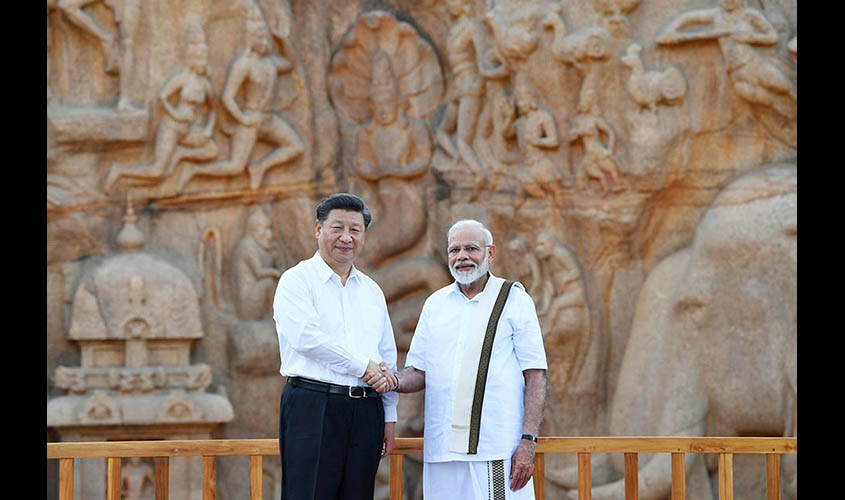The Wuhan summit, which was a personal initiative of Prime Minister Narendra Modi during his first term, opened a frank discussion between India and China, the two largest followers of Dharmic faiths. India and China are Dharmic cousins separated by political systems. Together they constitute 37% of the world’s population and 40% of world trade. Both countries have a common enemy—radical Islamic terrorism. On people to people contact, Dr Subramanian Swamy is a highly respected Indian politician in China. His communication with China constitutes India’s Track II diplomacy. China’s over confidence against India comes from their military victory over India in 1962. However, Chinese should also remember their defeat in Sikkim in 1967 against the Indian armed forces. In numbers, Indian and Chinese armed forces are 1:1, if we take the reserves into account. China has more equipment but the Indian armed forces excel in training, experience and rapid reach with superior qualitative equipment. The Doklam incident in 2017 also proved that the Indian armed forces held an edge over their Chinese counterparts. The myth of India’s 1962 military defeat has been used by Chinese media as psy-ops to humiliate Indian minds, but the fact is that in every single conflict after 1962, India has held an edge over the Chinese PLA in every theatre of war. Therefore, in military terms, India definitely has an edge over China today.
This Indian military edge has brought China to the negotiating table thanks to the dexterous moves made by the peace loving Prime Minister of a resurgent India, Narendra Modi. It is entirely to the diplomatic credit of PM Modi that he has brought long lasting peace on the Chinese border on the basis of the military strength of the Indian armed forces. Indians should not think that mere friendly gestures by PM Modi forced the Chinese to the informal summits. The history of communist China has shown repeatedly that they respect military strength more than the diplomatic strength. Otherwise, the Chinese won’t even wink at any negotiation just like what they have done in South China Sea. There, they bulldozed their way against ASEAN nations into making a permanent military installation in the middle of the ocean.
The advantage of Indian military build-up against the Chinese has enabled the magic of informal summits—from Wuhan to Chennai. For this spirit to continue, India has to put special emphasis on military equipment parity to ensure that India has at least 2:1 qualitative superiority over China and ability to perform military operations deep inside Chinese territory while engaging Pakistan on the western borders. This will dissuade China more for any adventurism on India’s borders or in the Indian Ocean.
Trade with China also has to be more controlled so that Chinese financial trapping schemes are dissuaded right at the outset. The Chinese are tough negotiators and very risk averse. The Chinese will never bring any innovative approach, unlike Indians. Their economy is on the supply side of value chain and they rely on demand side to be more risk takers, which is quite illogical. Throughout the world they have destroyed economies of smaller nations because those countries couldn’t negotiate well enough with the dragon. With the US, China got trapped in its own game but couldn’t do much against the US, because of China’s military strength vis-a-vis the US. Russia has been temporarily and financially trade trapped, but because Russia is militarily strong, China will not be able to bend them much.
The Wuhan and Chennai spirits are great but not enough to maintain and contain China’s expansionist mindset. So the elephant has to show its unpredictability and strength to continue to tango with the Chinese dragon. It’s the play of strength that matters. This tango will continue as long as: 1. India continues its military modernization and capability development; 2. India shows its willingness to take tough military decisions on the border; 3. India protects its neighbours from Chinese financial traps—India should rescue Sri Lanka from the Chinese debt trap; India should educate Nepal about the financial tactics of Chinese loan givers. 4. Indian Navy continues to build on its capabilities to ultimately become an expeditionary force to project its power on Chinese ports.
The Chinese respected the Pallava kings because of their strong naval power in addition to their trading skills. So it was a masterpiece by Modi to bring history into perspective for the Chinese leadership at the Mahabalipuram summit and this fact was very well understood by the Chinese. It’s time for the two most populous countries to be tied together on the basis of Dharma and also to protect Dharma.
To summarise, China and India share a common culture centred around Dharma. Both China and India share common enemies who are guided by Abrahamic values very different from Dharmic values. However, the ideology of China’s Communist Party is based on tough negotiations with neighbours using their military strength. India will have to expand its military strength to gain the respect of the Communist Party of China. India needs to publicly state that Taiwan, Hong Kong and Tibet are all on the table if Chinese resistance to UNSC permanent seat for India and support to Pakistani terrorism continues.

